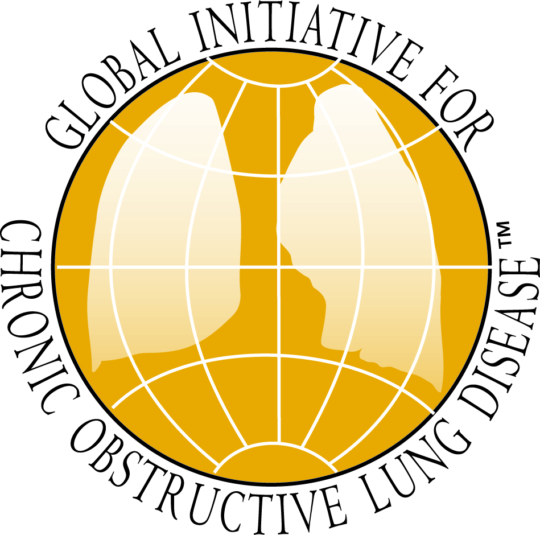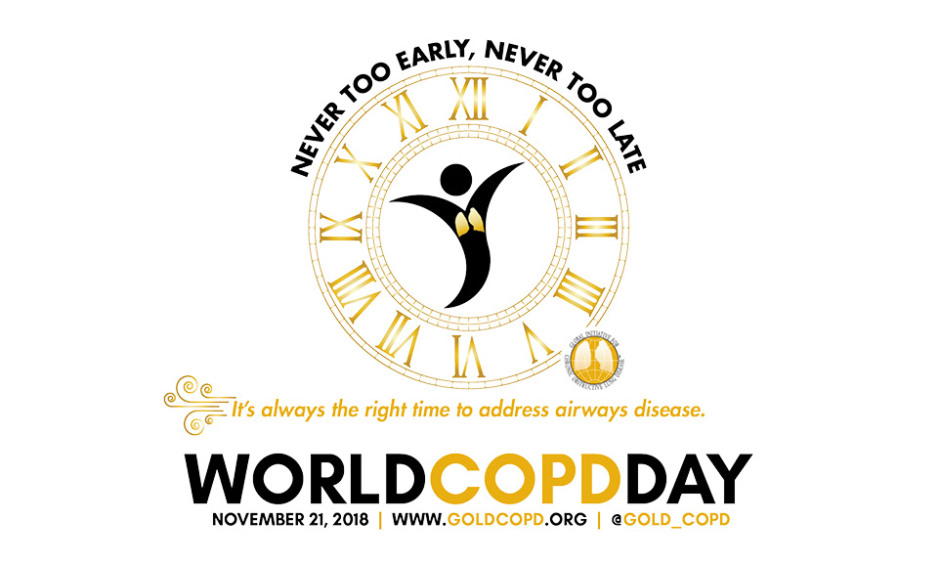An Interview with the Global Initiative for Chronic Obstructive Lung Disease (GOLD)
![]()
Written by James Coker | Reporter, European Medical Journal | @EMJJamesCoker
![]()
 Chronic obstructive pulmonary disease (COPD) is highly prevalent throughout the world and a major cause of mortality, with 5% of all global deaths estimated to have been caused by the condition in 2015.1 It is against this backdrop that the annual World COPD Day has grown in significance since the inaugural event back in 2002, with an increasing appreciation of the need to increase awareness of the condition and enhance our understanding of its risk factors. To find out more about this year’s event, which takes place on 21st November, and gain further insights into current strategies for tackling the condition, we spoke to the Global Initiative for Chronic Obstructive Lung Disease (GOLD), an organisation which organises World COPD Day in collaboration with healthcare professionals and COPD patients across the globe. GOLD have a large standing in this field of medicine and publish numerous evidence evidence-based strategy documents for COPD management for healthcare professionals. The insights were provided by Rebecca Decker, Program Director, GOLD, and Dr Alvar Agusti, Chair, GOLD Board of Directors.
Chronic obstructive pulmonary disease (COPD) is highly prevalent throughout the world and a major cause of mortality, with 5% of all global deaths estimated to have been caused by the condition in 2015.1 It is against this backdrop that the annual World COPD Day has grown in significance since the inaugural event back in 2002, with an increasing appreciation of the need to increase awareness of the condition and enhance our understanding of its risk factors. To find out more about this year’s event, which takes place on 21st November, and gain further insights into current strategies for tackling the condition, we spoke to the Global Initiative for Chronic Obstructive Lung Disease (GOLD), an organisation which organises World COPD Day in collaboration with healthcare professionals and COPD patients across the globe. GOLD have a large standing in this field of medicine and publish numerous evidence evidence-based strategy documents for COPD management for healthcare professionals. The insights were provided by Rebecca Decker, Program Director, GOLD, and Dr Alvar Agusti, Chair, GOLD Board of Directors.
Q: To what extent has World COPD Day evolved and developed since the campaign first began in 2002?
World COPD Day has always been a grass roots celebration and advocacy day, with the goal of improving awareness of COPD among the global healthcare community as well as the general public. In the early years, awareness campaigns were limited to the members of the GOLD Assembly (formerly called the GOLD National Leaders, a member network of Respiratory Specialists from around the world). However, in recent years, social media and technological advances in information sharing has allowed the campaign to have much deeper reach in all areas of the world. Healthcare providers can share photos and event status updates in real time via Twitter, Facebook, Linkedin, and Instagram.
Q: What have been the biggest highlights and successes from the World COPD Day campaigns over the years?
Success of World COPD Day events in any setting can be measured by increased awareness of prevention, diagnosis, and management of COPD. Today, I see success portrayed in free spirometry clinics, smoking cessation programs, charity walks and runs, caregiver training, and many other events that provide vital education on this devastating disease. Some of the most impactful campaigns are targeted towards highly vulnerable populations (mothers that cook with biomass fuels in low resource countries, workers in areas of noxious occupational exposure, adults who were faced with negatively impactful early life events such as premature birth or multiple childhood respiratory infections).
Q: The theme of this year’s event is ‘never too early, never too late’. Why was this theme chosen and what are the main outcomes you are hoping to achieve from this year’s campaign?
This theme was chosen to highlight the fact that COPD is a preventable and treatable disease at any stage and any age. Further, it emphasises recent research evidence that shows that about half of adult patients with COPD have evidence of abnormal lung development early in life (before and/or after birth). Although further research is still needed, this new information open windows of opportunity for early diagnosis, prevention, and treatment.
Q: Have you noticed an increased awareness of COPD amongst policymakers in recent years? What strategies are GOLD undertaking to ensure that the condition is treated as a public health problem throughout the world?
COPD currently is the third global cause of death and the only disease with increasing mortality among the top ten global causes of death. This critical fact has definitely elevated the importance of addressing airways diseases from a policy standpoint. One of the strategies that GOLD attempts to employ in educating the world about COPD is to stimulate healthcare providers to investigate ALL risk factors as potential mechanisms to drive the onset of COPD; including smoking, occupational exposures, genetic influences, outdoor and indoor air pollution, early life events, and any other factors that may affect lung health.
Q: Collaboration between organisations and healthcare professionals is a key aspect of the work of GOLD. How does GOLD try and ensure that new developments and knowledge of COPD accrue to patients from all parts of the world?
GOLD is entirely dedicated to global dissemination, as evidenced by our continued offering of open access reports and resources through our website: www.goldcopd.org. We average over 1,000 new healthcare professionals visiting our site to access GOLD strategy every day. We are attempting to increase our ‘virtual reach’ with some new technological initiatives coming very soon.
Q: What have been the most effective programmes for the diagnosis and management of COPD that GOLD has been involved with?
At this time, we do not have the human resources to follow the implementation of GOLD at the practitioner level, but we may do this in the future. However, we are fortunate to have a member network of advocates around the globe known as the GOLD Assembly. These physicians advocate for the implementation of GOLD strategy in their own countries and are vital to the mission of GOLD.
Q: What have been the most impactful research findings into COPD in recent years?
As mentioned above, the observation that COPD, which is typically diagnosed in later adulthood, can have its origins in early life (before or after birth), changes the traditional paradigm. There is no doubt that smoking is the main environmental risk factor that should be avoided but other risk factors related to poor lung development (including maternal smoking, poor nutrition, repeated respiratory infections during infancy, exposure to biomass cooking, among others) come into play too now.
Q: Environment appears to be a factor in the increasing prevalence of COPD. Are there any topics in particular relating to this that GOLD would like to see studied in greater depth?
The main environmental risk factor for COPD is active smoking. We have known this for the last 40 years and we should continue focussing on reducing its prevalence (as is happening in many parts of the world) and preventing smoking initiation in teenagers (which is not the case in many parts of the world). On the other hand, we now know as discussed above that other important risk factors for COPD come into play early in life. This realisation opens a window of opportunity for early diagnosis, prevention, and intervention. What the precise intervention needs to be is still being researched but avoiding smoking and indoor and outdoor pollution, providing appropriate vaccination, regular physical activity, and appropriate nutrition are likely to be beneficial. On the other hand, the potential efficacy and safety of other pharmacological interventions (such as vitamin A or C) during pregnancy or infancy are currently being investigated.
Q: What have been the main trends in regard to the prevalence of COPD over the years? Are there any particular challenges we face from this?
Over the last decades, the prevalence of COPD (and associated mortality and cost) has been on the rise, likely in relation to the ageing of the population. Now, we may face a new challenge, since the survival of low birth weight infants (e.g. premature babies) has increased enormously, so we may face a significant rise in the next few decades of survivors of severe prematurity whose lungs may have developed suboptimally.
Q: Are there any new initiatives being planned by GOLD that you can tell us about?
GOLD is driven by our four main pillars: Financial independence, Global dissemination, Precision medicine, and Dedication to patients. We recently hosted a 1-day summit with physicians representing various resource-stratified countries in an attempt to discover what GOLD may be able to do to move COPD forward in global care. We were overwhelmed to discover that even the most basic diagnostic tools and prevalence data simply do not exist in many parts of the world. It is apparent to us that these challenges must be approached firstly through education, then infrastructure building, and finally strategy implementation. Our initiatives will always focus on maximising patient outcomes while at the same time reduce provider burden, and new developments in these areas are already underway.
For further questions or to submit your World COPD Day activities, please visit www.goldcopd.org.
REFERENCES
- World Health Organization. Chronic obstructive pulmonary disease (COPD). Available at: http://www.who.int/news-room/fact-sheets/detail/chronic-obstructive-pulmonary-disease-(copd). Last accessed: 8 November 2018.








